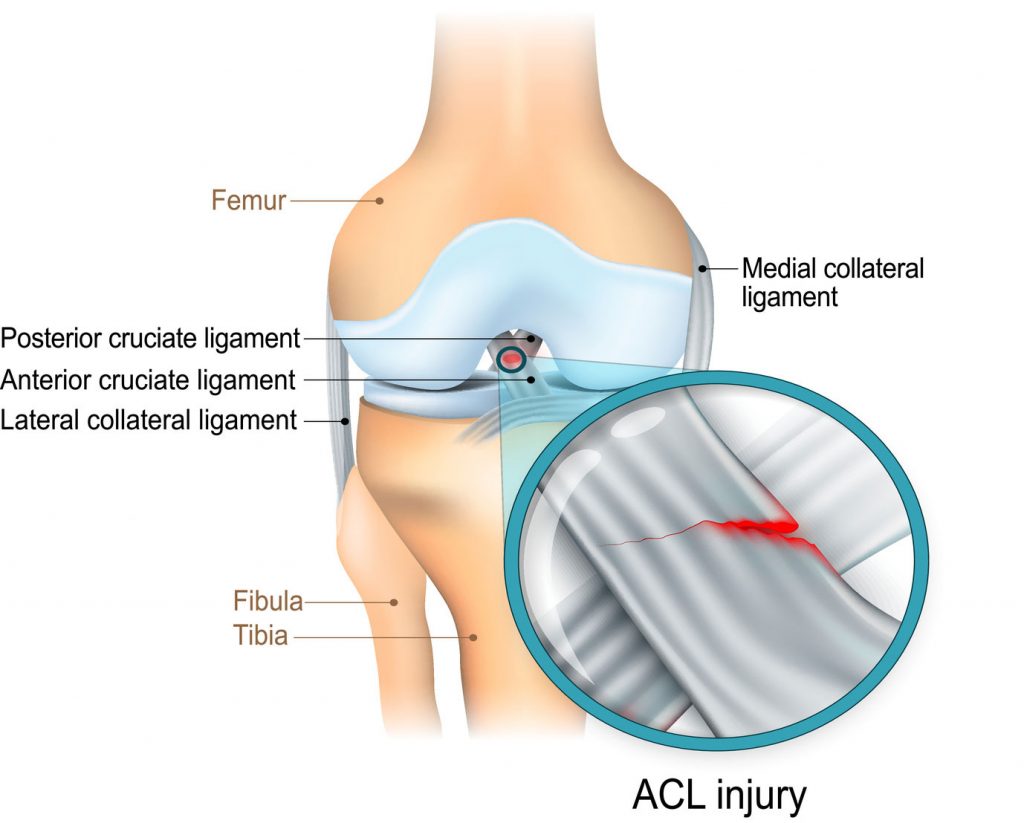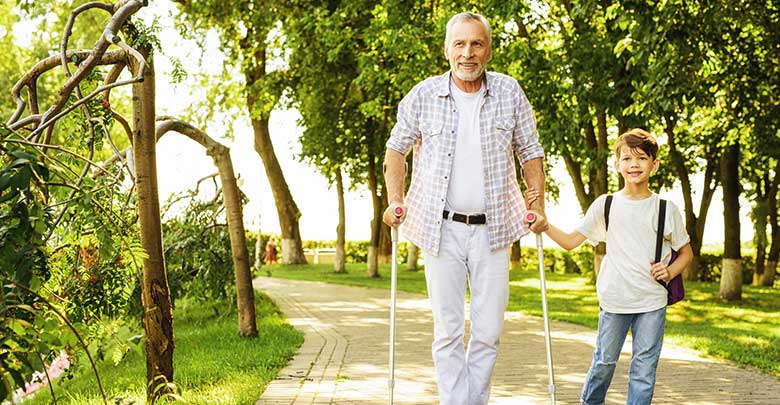
Knee ligament injuries can happen suddenly and unexpectedly
Anyone who has fallen victim to a knee ligament injury will be able to confirm how debilitating and painful these kinds of injuries can be. But how much do you know about the ligaments in your knee, and whether you need to see a doctor or physiotherapist?
USE the OMH exclusive code "HEALTH15" to Save 15%Knee ligament anatomy
The most common knee injuries affect the knee ligaments. Ligaments are tough fibrous bands of connective tissue that connect one bone to another bone. The knee has many ligaments, but the most commonly injured ones are the medial collateral ligament (MCL), lateral collateral ligament (LCL), and the anterior cruciate ligament (ACL).

The ACL is a tough ligament that runs from the the front of the tibia (shin bone) to the back of the femur (thigh bone)
ACL tear (anterior cruciate ligament) – anatomy and symptoms of a torn ACL
The ACL is a tough ligament that runs from the the front of the tibia (shin bone) to the back of the femur (thigh bone)
Extreme stress on the ACL may cause over stretching of the ligament which leads to laxity of the ligament. Sometimes there may be a partial tear or possibly a complete tear of the ACL ligament. ACL injuries may be caused by:
- sudden and forceful twisting motion of the knee joint
- hyper-extension (excessive straightening force to the knee)
- landing awkwardly from a jump
An injury to the ACL is unique in that the symptoms it causes are severe and sudden swelling of the knee – your knee may look the size of a grapefruit, within a very short time. This is due to the fact that the ACL is situated within the joint capsule, and a complete tear therefore causes extreme and sudden swelling, pain and limitation of movement in the knee. There could also be a popping sound when the ACL injury occurs, or the joint could feel unstable, with a bit of laxity in the joint. If you experience any of the above symptoms, it would be advisable to consult your trusted physiotherapist and orthopaedic surgeon.
MCL knee injuries (medial collateral ligament) and LCL knee injuries (lateral collateral ligament)
Injuries and tears to the LCL and MCL in the knee may be as a result of excessive force applied to the inside or outside of the joint, which cause the ligaments to be placed under excessive strain. These injuries are often very painful, although they seldom result in excessive swelling, and you would not usually hear or feel a pop. Typically these ligament injuries to the MCL or LCL, on their own, respond very well to conservative – in other words non-surgical – management. However these LCL and MCL knee ligament injuries can sometimes be associated with injuries to other structures such as the meniscus and /or the ACL, in which case the knee injury is more serious, and would definitely require management by a physiotherapist and orthopaedic surgeon.
Treatment for knee ligament injuries
For any knee ligament injury it is important to follow the RICE principle in the first few days:

- Rest the affected knee for at least the first two days. If you are having difficulty walking normally and cannot put full weight on your knee, find out from your local medical centre where you can acquire crutches to normalise your gait pattern as much as possible and avoid painful weight bearing.
- Ice will assist in reducing swelling and inflammation. Always put ice in a cloth or bag to avoid direct contact with the skin, and only use for 20 minutes at a time.
- Compression will prevent too much swelling. An elastic compression band can be worn during the day. Remember to remove it when going to sleep.
- Elevation will reduce swelling. Putting your leg up higher than your heart will prevent the knee from swelling too much. You can also pump your foot to encourage circulation.
Should you see a medical professional for your knee injury?
For any suspected knee ligament injuries, it is always advisable to see a medical practitioner. If you are struggling to walk, experience severe swelling or if you are in pain you should go to your nearest hospital or to a medical professional as soon as possible.
If your injury is mild, once you have rested your injured knee for the appropriate amount of time, you should try to start moving around as normal. Gently stretching, strengthening and mobilising the knee will assist in restoring normal movement.

Physical therapy advice for knee ligament injuries
Check our Physiotherapist, Karin’s recommendation for a 10 minute exercise series which can support your ACL tear healing process and download the PDF page which will help you to follow this routine anytime and anywhere.
When weaning off the crutches (if they were necessary) try to walk with normal heel-toe gait, and without limping by stabilizing your hips and core. This will normalize the load bearing at your knees, and encourage normal muscle engagement. It is highly recommended that you follow the strengthening and rehabilitation programme, in order to regain full range of motion and strength before easing yourself into returning to sport. If you are still experiencing pain once the swelling and inflammation is down (usually this stage lasts 2 weeks), or your knee is stuck, feeling unstable or giving way, you may have to go for physiotherapy. In addition to therapy, the physiotherapist will prescribe an exercise programme to strengthen and stabilize your knee as you can see in Karin’s video series here.
As mentioned before, if your symptoms are severe you are recommended to see a specialist like an orthopedic surgeon. Should it so happen that one or more of your knee ligaments were torn completely, you may require surgery. After surgery you will be prescribed an extensive course of physiotherapy which will likely include very similar exercises as in the case of for non-surgical therapy. So, check out our physiotherapists’ recommendations